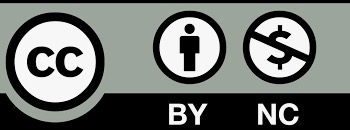Published
2024-03-13
Issue
Section
Research Articles
License
The journal adopts the Attribution-NonCommercial 4.0 International (CC BY-NC 4.0), which means that anyone can reuse and redistribute the materials for non-commercial purposes as long as you follow the license terms and the original source is properly cited.
Author(s) shall retain the copyright of their work and grant the Journal/Publisher rights for the first publication with the work concurrently licensed since 2023 Vol.8 No.2.
Under this license, author(s) will allow third parties to download, reuse, reprint, modify, distribute and/or copy the content under the condition that the authors are given credit. No permission is required from the authors or the publisher.
This broad license intends to facilitate free access, as well as the unrestricted use of original works of all types. This ensures that the published work is freely and openly available in perpetuity.
By providing open access, the following benefits are brought about:
- Higher Visibility, Availability and Citations-free and unlimited accessibility of the publication over the internet without any restrictions increases citation of the article.
- Ease of search-publications are easily searchable in search engines and indexing databases.
- Rapid Publication – accepted papers are immediately published online.
- Available for free download immediately after publication at https://esp.as-pub.com/index.php/ESP

Copyright Statement
1.The authors certify that the submitted manuscripts are original works, do not infringe the rights of others, are free from academic misconduct and confidentiality issues, and that there are no disputes over the authorship scheme of the collaborative articles. In case of infringement, academic misconduct and confidentiality issues, as well as disputes over the authorship scheme, all responsibilities will be borne by the authors.
2. The author agrees to grant the Editorial Office of Environment and Social Psychology a licence to use the reproduction right, distribution right, information network dissemination right, performance right, translation right, and compilation right of the submitted manuscript, including the work as a whole, as well as the diagrams, tables, abstracts, and any other parts that can be extracted from the work and used in accordance with the characteristics of the journal. The Editorial Board of Environment and Social Psychology has the right to use and sub-licence the above mentioned works for wide dissemination in print, electronic and online versions, and, in accordance with the characteristics of the periodical, for the period of legal protection of the property right of the copyright in the work, and for the territorial scope of the work throughout the world.
3. The authors are entitled to the copyright of their works under the relevant laws of Singapore, provided that they do not exercise their rights in a manner prejudicial to the interests of the Journal.
About Licence
Environment and Social Psychology is an open access journal and all published work is available under the Creative Commons Licence, Authors shall retain copyright of their work and grant the journal/publisher the right of first publication, and their work shall be licensed under the Attribution-NonCommercial 4.0 International (CC BY-NC 4.0).
Under this licence, the author grants permission to third parties to download, reuse, reprint, modify, distribute and/or copy the content with attribution to the author. No permission from the author or publisher is required.
This broad licence is intended to facilitate free access to and unrestricted use of original works of all kinds. This ensures that published works remain free and accessible in perpetuity. Submitted manuscripts, once accepted, are immediately available to the public and permanently accessible free of charge on the journal’s official website (https://esp.as-pub.com/index.php/ESP). Allowing users to read, download, copy, print, search for or link to the full text of the article, or use it for other legal purposes. However, the use of the work must retain the author's signature, be limited to non-commercial purposes, and not be interpretative.
Click to download <Agreement on the Licence for the Use of Copyright on Environmental and Social Psychology>.
How to Cite
The difference in the world perception between a hysteric and a neurotic
Liana Spytska
Department of Psychology and Pedagogy, Kyiv International University
DOI: https://doi.org/10.54517/esp.v9i6.2229
Keywords: emotional state labiality, personality disorder, brain functioning, nervous system, stress
Abstract
The research significance is determined by the necessity to gain a more profound comprehension of the influence of mental disorders on an individual's perspective of the world. The research intends to conduct an empirical study to identify and compare the levels of personal indicators of world perception in individuals with hysterical and neurotic disorders. The methodology employed in investigating this issue involved surveying participants, which gathered data on the psychological condition and perception of the environment among the individuals involved in the study (n=62). The study employed various methods of scientific inquiry, including system analysis, comparison method, logical analysis, classification, synthesis, and deduction, in addition to conducting interviews with the respondents. It defines the terms “neurotic” and “hysteria”, describes the causes and consequences of an unstable emotional state, determines the connection between an unstable emotional state and neurotic and hysterical personality disorders, uncovers potential physiological causes for the development of these disorders, lists and describes physiological and sociocultural factors that shape a person's worldview, and explores personal factors that influence. The research materials possess practical significance as they provide empirical evidence of the impact of hysterical and neurotic personality disorders on an individual's perspective of the world.
References
[1]. Koerber A. From hysteria to hormones. A rhetorical history. Penn State University Press; 2018.
[2]. Sihn K. Distinguishing between neurosis and psychosis: Discourses on neurosis in colonial Korea. History of Psychiatry. 2022, 33(3): 350-363. doi: https://doi.org/10.1177/0957154x221094945
[3]. Barlow DH, Curreri AJ, Woodard LS. Neuroticism and disorders of emotion: A new synthesis. Current Directions in Psychological Science. 2021, 30(5): 410-417. doi: https://doi.org/10.1177/09637214211030253
[4]. Gugushvili N, Taht K, Schruff-Lim EM, ey al. The association between neuroticism and problematic social networking sites use: The role of fear of missing out and self-control. Psychological Reports. 2022. doi: https://doi.org/10.1177/00332941221142003
[5]. Liang HL. Compulsory citizenship behavior and facades of conformity: A moderated mediation model of neuroticism and citizenship pressure. Psychological Reports. 2022, 125(6): 3141-3161. doi: https://doi.org/10.1177/00332941211031794
[6]. Kondracki AJ, Riedel MC, Crooks K, et al. The link between neuroticism and everyday cognitive failures is mediated by self-reported mindfulness among college students. Psychological Reports. 2023, 126(1): 265-287. doi: https://doi.org/10.1177/00332941211048467
[7]. Madubata IJ, Cheref S, Eades ND, et al. Non-suicidal self-injury, neuroticism, and ethnic identity in young Latina adults. Hispanic Journal of Behavioral Sciences. 2020, 42(4): 528-546. doi: https://doi.org/10.1177/0739986320950914
[8]. Barkhatova A, Popov S, Sorokin S. Psychopathological features of hysterical disorders arising as part of affective disorders and schizophrenia. European Psychiatry. 2022, 65(Suppl 1): S564. doi: https://doi.org/10.1192%2Fj.eurpsy.2022.1443
[9]. Eysenck HJ, Eysenck SBG. Manual of the Eysenck Personality Questionnaire. Hodder and Stoughton; 1975.
[10]. Shostrom EL. An inventory for the measurement of self-actualization. Educational and Psychological Measurement. 1964, 24(2): 207-218. doi: https://doi.org/10.1177/001316446402400203
[11]. Mostowik J, Mielimąka M, Rutkowski K, et al. Time in the mental health context: Neurotic symptomatology, defence mechanisms and the perception of time perspective among patients diagnosed with neurotic and personality disorders – A clinical study. Psychological Reports. 2022. 125(1): 232-255. doi: https://doi.org/10.1177/0033294120978164
[12]. Zhovtianska V. Does attitude really exist? The anticipation model of implicit attitude. Scientific Studious on Social and Political Psychology. 2023, 52(55): 23-33. doi: https://doi.org/10.61727/sssppj/2.2023.23
[13]. Cheng B, Yang X, Cheng S, et al. A large-scale polygenic risk score analysis identified candidate proteins associated with anxiety, depression and neuroticism. Molecular Brain. 2022, 15: 66. doi: https://doi.org/10.1186/s13041-022-00954-3
[14]. Ronzhes O. Digital application as tools for psychological adaptation of citizens to changes. Scientific Studious on Social and Political Psychology. 2023, 52(55): 34-46. doi: https://doi.org/10.61727/sssppj/2.2023.34
[15]. Morsy SK, Aybek S, Carson A, et al. The relationship between types of life events and the onset of functional neurological (conversion) disorder in adults: A systematic review and meta-analysis. Psychological Medicine. 2022, 52(3): 401-418. doi: https://doi.org/10.1017/s0033291721004669
[16]. Helleman A, Rubin RT, Gardner W, et al. Circadian cortisol secretion in adolescent girls with conduct disorder. Psychoneuroendocrinology. 2023, 148: 105972. doi: https://doi.org/10.1016/j.psyneuen.2022.105972
[17]. Prib H, Bobko O. Psychology characteristics of entrepreneurs working in stress-related conditions. Scientific Bulletin of Mukachevo State University. Series “Pedagogy and Psycology”. 2023, 9(2): 57-67. doi: https://doi.org/10.52534/msu-pp2.2023.57
[18]. Braun J. Performing hysteria: Images and imaginations of hysteria. Leuven University Press; 2020.
[19]. Zhao G, Cheng Q, Dong X, et al. Mass hysteria attack rates in children and adolescents: a meta-analysis. Journal of International Medical Research. 2021, 49(12): 3000605211039812. doi: https://doi.org/10.1177/03000605211039812
[20]. Haw AL. ‘Manufactured hysteria’: Audience perceptions of sensationalism and moral panic in Australian news representations of asylum seekers. Media International Australia. 2020, 174(1): 125-139. doi: https://doi.org/10.1177/1329878X19876093
[21]. Junca-Silva A, Vilela C. The black unicorn effect: Micro-daily events and satisfaction decrease the COVID-19 xenophobia, but only for those with low levels of neuroticism. Psychological Reports. 2023. doi: https://doi.org/10.1177/00332941231161278
[22]. Frankenbach J, Wildschut T, Juhl J, et al. Does neuroticism disrupt the psychological benefits of nostalgia? A meta-analytic test. European Journal of Personality. 2021, 35(2): 249-266. doi: https://doi.org/10.1002/per.2276
[23]. Pearson A, Pfeifer G. Two measures of interceptive sensibility and the relationship with introversion and neuroticism in an adult population. Psychological Reports. 2022, 125(1): 565-587. doi: https://doi.org/10.1177/0033294120965461







